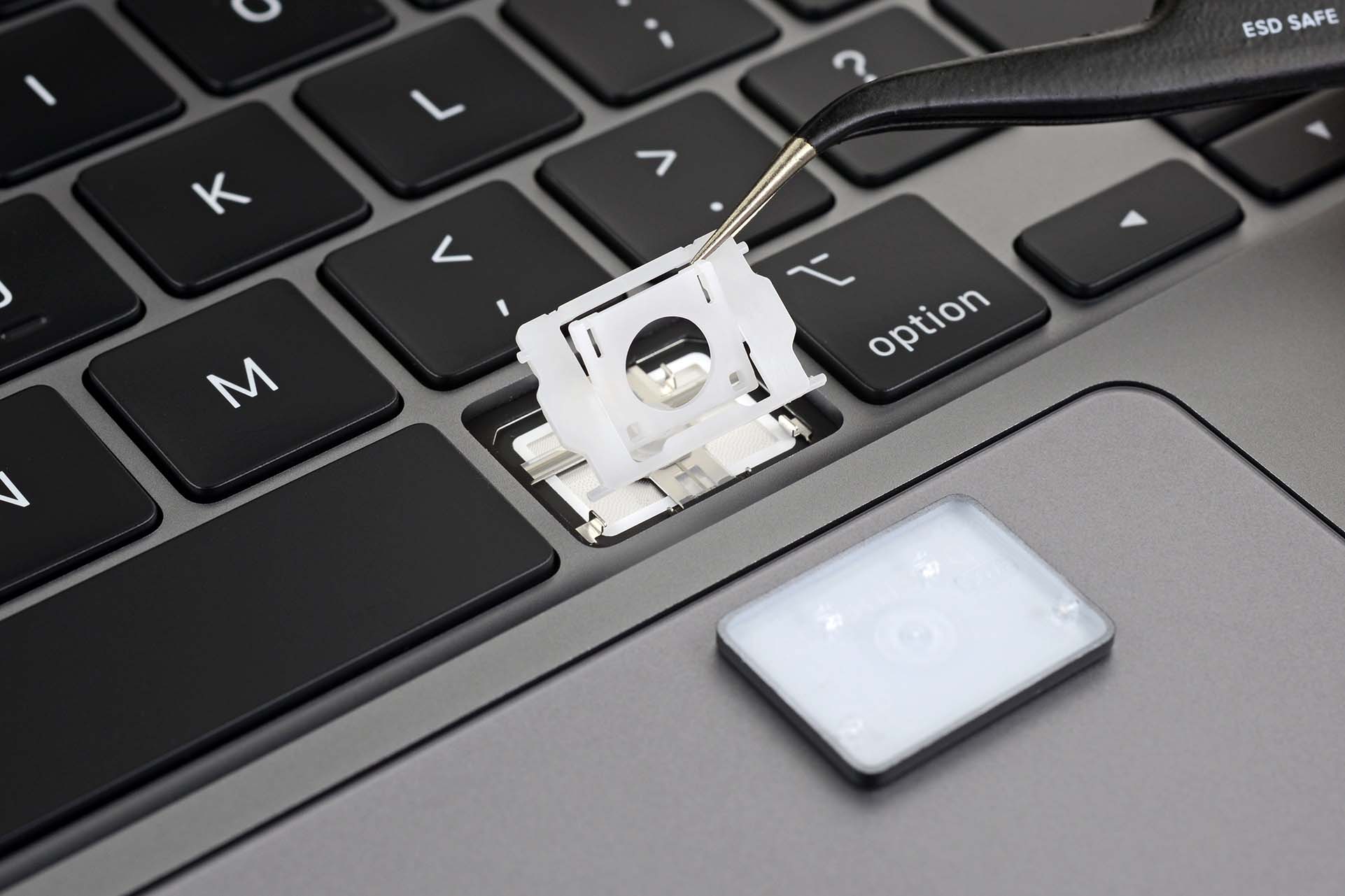Your long butterfly keyboard nightmare is over. The new Magic Keyboard in the 16-inch MacBook Pro has an almost identical look and feel to much older Apple devices—so close, in fact, that you can swap in old Magic Keyboard keycaps. It feels like a do-over, a throwback, almost an apology.
Customers, press, and those of us who care about device longevity have scored a win. These new keys, which are essentially the old keys, have deeper travel, softer sound, and a more robust design. Replacing a broken switch mechanism still involves disassembling the whole device, and will likely be painful, but, still: this is a practical move, and one we could not have expected until recently.
Apple’s not exactly surrendering, though. Their four-year keyboard hostage negotiation with MacBook buyers seems to have paid off handsomely. Early reviews are full of Stockholm Syndrome swoon, with high praise for keys that don’t feel or sound bad. Meanwhile, the company has only barely admitted to “some quality issues.” Don’t get us wrong; adding function at the expense of negligible size and weight increases is a step in the right direction. But we have to wonder if a similar outcry could make Apple reconsider making other parts of their esteemed laptop more simple and repairable.
When we lost the Magic

Before there were butterflies, there was Magic. Before there was a “Magic” keyboard, actually, Apple simply called their own take on a scissor-switch input device the Apple Wireless Keyboard. It evolved into a Magic Keyboard in October 2015. By Schiller’s own admission, this keyboard was a fan favorite for years, but was Apple satisfied? Of course not.

Apple’s patent for “Low-Travel Key Mechanisms Using Butterfly Hinges” states that “it is often desirable to reduce the size of electronic devices,” but keyboards “may occupy relatively large portions of the available interior space.” In other words, all that comfortable key travel takes up vertical room that would be better used as … nothing.

Butterfly keys with 0.7 mm travel first showed up in the Retina MacBook of March 2015. We had some reservations about the plastic hinge fatiguing, but were cautiously optimistic that fewer moving parts meant fewer breakdowns.
October 2016 brought the 13-inch MacBook Pro. In our teardown (of the model that still had function keys), we noted that the second version of butterfly keys had a dome switch that “appears to be heftier and better mated to the keycap” than the MacBook. The Retina MacBook of June 2017 was much the same, but this time spotted a switch with “a new, slightly thinner frame.”
Enter the butterfly
People who used these MacBooks instead of taking them apart often complained that typing on them was loud and felt crunchy. An editor I worked with at the time compared it to typing on a pizza box. In October 2017, Casey Johnston wrote about needing her keyboard fixed three times in one year. Apple’s “fix” was to take her MacBook for days at a time and return it with a new keyboard. Johnston’s issue was the spacebar, which almost nobody, not even Apple’s own techs, could remove without breaking.
Apple made their replacement policy official in June 2018, with a four-year extension on keyboard warranties. We detailed how and why they had engineered their own downfall. “The basic flaw,” wrote Kyle Wiens, “is that these ultra-thin keys are easily paralyzed by particulate matter. Dust can block the keycap from pressing the switch, or disable the return mechanism.” We also detailed the unfixable issue in a video.
People noticed. A class-action lawsuit filed in May 2018 claimed that Apple was aware of the problems right after the first butterfly-equipped MacBook, but continued to sell and tout the design. Helping with this argument was a patent for an ingress-protecting membrane for key switches, filed in Sept. 2016 but only made public in March 2018. The membranes showed up in the MacBook Pro 13-inch Touch Bar from 2018, which also had an easier-to-remove spacebar that seemed like anything but a coincidence.
We tore down the keyboard itself and tested its ingress protection. The membranes helped, but they were not foolproof. Particles can get in through the cut-outs that accomodate the butterfly hinges and seize the keys.
Meanwhile, Apple, whether due to brand image or legal liability, maintained publicly that the membranes were a fix for noise issues, not particle ingress, despite internal service documents saying the exact opposite.
It was a cover-up, and we said as much.

The 13-inch MacBook Air of November 2018 had the same third-attempt switches and membrane. By March 2019, the issues were piling up. A new MacBook Pro in May 2019 had a “change to a material in the keyboard mechanism,” Apple told Wall Street Journal columnist Joanna Stern. We went deep into these keys in our teardown, discovering a new silicone-like plastic over the dome switch, and that the switches themselves had new metals, new heat treatments, or maybe both.

Suffice to say, none of these changes fixed the issue. On some of the most expensive consumer laptops available, the keys still didn’t feel great, broke more often than on cheap laptops, and were a costly, time-consuming repair, whether for Apple or the out-of-warranty customer. By July 2019, a couple months after their latest model, Apple was reportedly ready to give up on butterflies.
What’s different about these Magic scissors

The new Magic Keyboard in the 16-inch MacBook Pro uses a scissor switch that looks almost identical to the switches in the desktop Magic Keyboard, and MacBooks sold before the butterfly blunder. The switch is two plastic pieces, crossed, with a pivot in the middle to control key movement. It’s more robust than butterfly switches, and there’s more space to tolerate debris within its movements. This is backed up by the lack of a membrane around the keys, and the lack of an extended warranty (so far) on this keyboard. Apple seems confident about durability (or noise levels, perhaps).
Compared to the butterfly keyboards, the new keyboards have about 0.5 mm more travel when you press them. The keycaps are about 0.2 mm thicker. The tiny clips that attach the keycaps to the scissor switches seem reinforced, so that there’s a lower chance of breaking them and ruining the keycap when you pull it off for cleaning or repair. Now you have a way better chance of getting the cap off and back on intact.
You’ll be able to see more of the keyboard when we post our full teardown of 16-inch MacBook Pro on Monday.
We could have more nice things like this, if we demanded them

After that four-year journey through the dusty badlands, we’ve arrived at a MacBook Pro that has a functioning keyboard, and isn’t functionally much thicker or heavier than those that didn’t. You can tell the difference if you compare them side-by-side, carefully; otherwise, it feels like a sleek, slim MacBook. We’re certain Apple was loath to give up on something Designed by Apple in California, but they heard the outcry of customers and came to a sensible solution: using a technology that worked and was (moderately) repairable.
Imagine if we could push Apple to make other parts of their acclaimed device easier to repair on a part-by-part basis. Consider how they might respond if hard-to-replace ports and batteries, or soldered-on memory and storage sparked people’s ire.
It’s a bittersweet moment to see that we’ve ended up here, right where we started, but it’s possible to see a different path forward.





42 Comments
I’d actually buy one of these, but where the heck is the 4G LTE version? Why the f*ck doesn’t Apple make a laptop with 4G support so you can get on the internet anywhere? Currently typing this on an HP Elitebook with 4G LTE where there’s no public WiFi available. If I had a $5,000 MacBook I couldn’t be typing this right now. I mean, ALL laptops should have a 4G option. Of course, I’m sure in 10 years Apple will put 6G or whatever in their newest MacBook and claim that they were the first to build a laptop where you can get on the internet from anywhere. That’s Apple’s typical MO - put in 10 year old technology then claim they were the first to ever use it. I’m surprised that their cheapest $2,400 16” MacBook has a 512GB SSD instead of the 250GB they’ve had for like 5 years. I mean, they’re Apple, right? Surely they could have stayed with a 250GB SSD for another 5 years and people would have still bought them.
Jake Wilson - Reply
What is the point of 4G conn in laptop since all smartphones can act as a hotspot ?
Oskar -
If you actually worked for a living you’d know that a hotspot kills your battery within hours and is a pain in the a$$ and having a separate mobile hotspot forces you to carry around a separate device that has to be charged separately.
Your argument makes about as much sense as someone saying: “Why do we have cordless phones when you can just have a phone with a cord?”
It makes no sense. You might as well make the same argument for smartphones. What’s wrong with carrying around a separate hotspot in order to make a call? You can just connect your phone to the hotspot. What a pain in the a$$.
Jake Wilson -
I'm writing this from a laptop via phone hotspot. There's no need for a lte sim in a macbook.it’s like asking for a notebook with sim, when you always carry a phone with you anyways, which can easily be charged by the computer youre using it with.
Daniel Klose -
I agree with you: the convenience of having built-in 4G/LTE connectivity is something I’ve been wanting for years (and why I have it on my iPad and Apple Watch — hotspots be damned, haha). Frustratingly, though, I don’t think we’ll see Apple add this feature until they have an ARM-based laptop using one of their in house A-series chips.
devonair -
Within Apple’s ecosystem there is a solution, and that’s use connection sharing from your iPhone. It works reliably, does not influence THAT MUCH battery life, and other solutions would require too much effort and engineering time. 4G in a MacBook will _NEVER_ happen.
Rade Martinović -
Actually a very simple answer: cellular revisions become obsolete more quickly than the life of Apple’s laptops. You want LTE? Just tether, using the cellphone that absolutely every human on earth who owns a laptop already has. Cellular connectivity in a laptop is a stupid idea. It means an extra subscription that you have to buy. Apple has made the right choice here. Your ##&&%&%& about SSD sizes is similarly uninformed and troll-esque; Apple offers SSD sizes of 512GB up to 8TB on this model. Show me a PC laptop that has an 8TB SSD. Lastly, no, it is emphatically not “Apple’s MO” to put in “10-year old technology”; Apple was in fact the first to ship WiFi in a laptop, the first to ship Thunderbolt, the first to ship Thunderbolt 2, the first to ship Thunderbolt 3, etc. These were all brand-new technologies and standards at the time Apple shipped them.
jeff -
Clearly, they’re doing it to stop you from posting, and I support this decision.
Annie Montgomery -
We know from iPhone licensing disputes that Qualcomm demand licensing fees for cellular modems that are based on a percentage of the total cost of the device the modem is shipped in.
That to me doesn’t sound like “fair, reasonable, and non-discriminatory” terms to license a standards essential patent—and given that percentage isn’t trivial it also makes clear why Apple would never include a cellular modem in a MacBook Pro under those conditions.
Apple have settled their litigation with Qualcomm and it may well be the two agreed to different terms that would change this metric. I for one still wouldn’t pay a second cellular account bill for my MacBook Pro. Tethering is fine.
Duncan Babbage -
Apple does not make a laptop with built in cellular, for the simple reason that macOS does not have any good support for distinguishing between different types of networks.
If you look at Windows, for example, they have the concept of private vs public networks. This means you can easily configure your laptop not to, say, download a 150GB update over your LTE connection. macOS doesn’t have that - despite having a ‘location’ concept associated with networking since the first version of OS X.
Putting in cellular networking without having OS-level differentiation of the types of network would be an insane move.
You’ll know the next round of Mac laptops will offer cellular when Apple unveils a per-network permission model at WWDC. Until then, stop expecting something that will not happen.
Robert Watkins -
WTF are you talking about? Apple was first to do a ton of stuff, including the first wifi laptops. Your MO is to make stuff up. Be gone, troll.
ophello -
I don’t think you can claim you wouldn’t be able to type that right now on a Mac. Most phone plans allow hotspot connectivity. Which should be plenty enough to type a comment on the web. I do concede that it’s unfortunate to not have a separate cellular plan for the data being used by your computer as most cell plans cap hotspots to 15gb of data. However, I don’t think you’d be in danger of hitting that cap with as little data as you used to post this comment. I don’t think lte equipped computers are a mainstream concern for most people and with hotspots on phones, why waste the money implementing that into a laptop. Food for thought.
brennan14 - Reply
Your phone battery will die within a few hours if you use it as a hotspot. And it’s butt a$$ inconvenient. Why don’t we just go back to having corded phones? Because they sucked, that’s why.
Jake Wilson -
I concur Jake. Back in the days I purchased 3G modem for my laptop (PCI-e, not an external one, oh the good stuff we used to have…) mostly for fun, but boy was it nice to use. Not being forced to enable hotspot on a phone when you wanted to go online it’s such a convenience you really need to try to appreciate. And does it perform better - laptop has bigger antennas, so connection is stronger and more reliable. And it’s more efficient - you can disable wifi on laptop and only spend battery on cell connection, where as with hotspot you spend laptop for wifi, and cellphone for wifi and cell.
Vitaliy Kurokhtin -
How are the SSD and RAM inside? Soldered? One or two SSD sticks? Standard connenctor? RAID? A full take apart – disassembly – teardown would be great. Thanks!
Peter Gamble - Reply
Your answer is right there in the article:
Tom -
SSD and RAM are soldered to the board, as in all recent MacBook Pros. There’s not room for any other solution. Storage is also integrated with the T2 chip for security reasons.
jeff -
Ultimately demand is not what caused this, it’s the money it cost Apple. The fact that the machine isn’t as repairable or lacks an SD card slot or whatever doesn’t really matter. None of those caused hundreds of angry people to make the trip to the Apple Store or AASP to get their machines repaired under warranty, or their machines replaced for free after numerous repairs, or Apple spending time and resources on numerous band-aid fixes. This is a money decision, not a goodwill decision. A goodwill decision would have been offering a discount or even more to those that have been affected by issues with the butterfly keyboard.
Nick Fugitt - Reply
Apple actually offered something better than a discount; they offered free out-of-warranty keyboard replacements to all those affected. This makes the user whole without requiring them to buy new hardware.
jeff -
The flaky keyboard on these recent MacBooks are what turned me off from buying one, just as I was ready to buy my first Apple laptop. A couple of lines in ‘Notes’ on that keyboard convinced me that it would never work. I am very sensitive to the quality of the keyboard and I feared this was the future for Apple keyboards from here on out. They are simply dreadful and I would never have considered buying a MacBook and I’ve been an Apple customer for 25 years.
Howard Treesong - Reply
Great info. Thanks. Any idea if the MacBook Air will be coming out with the new (old) keyboard…ever…soon?
allison - Reply
There is no need for LTE. With a Mac and iPhone you can just click connect, the computer tells the phone to activate Hotspot mode on the phone and you are connected right away. Very seamless and well integrated.
tech - Reply
All I see is that Apple still insists to force the awful TouchBar down everyone’s throat. Place it above the Fn Keys or make it an option. Everything else is just ruining the workflow for people who want physical keys.
mister tamura - Reply
Actually I still miss user replaceable SSDs. If it has gone wrong, or the motherboard, I could either easily plug in a new one or at least get my data and have a still usable SSD instead of a big chunk of junk.
That’s something the “Pro” moniker should stand for - the “Pro” user can solve issues by him/herself, instead of waiting a week or longer for a repair.
Noon - Reply
I solved the keyboard issue in my 2016’s MacBook Pro by buying a wireless mechanical keyboard with brown Cherry switches LOL
Broke like 9 keys of my MacBook's keyboard, got it replaced under the warranty but I'm a woman and a very light typist, so it surprised me it broke so easily…. Now I'm out of the warranty so I've decided to do not take the risk anymore - mechanical keyboard all the way from now on, € 140 and I got a super cool wireless/cabled mechanical keyboard with Cherry brown switches, macros, different profiles, RGB and Bluetooth, 100% compatible with MacOS. Also awesome for gaming and long typing sessions.
Deborah Epstein - Reply
Will need to do a refresh of Apple laptops in a year or two. Without upgradability of SSD and glued in battery, I’m hesitant to buy new Apple laptops. The older laptops had replaceable batteries, and keyboards. It might be we just upgrade to old Macbook pros given the state of things. Don’t need black stickers on internal coils, but do need repairable insides. Up to you Apple if you want my business.
Richard Burton - Reply
Apple's already gave everyone free keyboard replacements on MacBooks that were out of warranty. Just because a battery is glued in doesn’t mean it can’t be replaced. Apple charges $129 to $199 depending on the model to change the battery in MacBooks. I already pointed out the 2019 16” has the biggest SSD and fastest SSD’s you can buy period. 8TB and 3,200 MBps. It sounds like you buy the smallest SSD and then complain when it fills up. Nobody is forcing you to buy a 256GB or 512GB SSD when 8TB’s is available now.
Radiation Network -
Don’t mind soldered RAM if we get more speed, but Storage is progressing too fast to solder SSD in. Also don’t need Apple proprietary SSD. Apple really needs to go back to serving customers than !#^&^$^ is all off.
Richard Burton - Reply
You do know Apple’s 16” 2019 SSD’s are the fastest and largest SSD’s you can buy in any laptop? 3,200 Mega Bytes per second. that’s 3.2 Giga BYTES per second or if you’re comparing it to gigabit wifi that’s 25.6 Gigabits per second. I ordered the 4TB but the 8TB is available. The bus is already saturated so even if you could upgrade the speed won’t change much.
Radiation Network -
I actually like the butterfly keyboard and haven’t had a problem with it, maybe because I have the newer model. I think Kyle’s comment that the Butterfly keyboard is “garbage“ is garbage. His comments are lopsided, like no one he spoke to liked the keyboard is also false, I know plenty of users who prefer the new Butterfly.
suhail - Reply
I have to agree. It is much more pleasant and fast to type on if you ask me.
The new 16-inch’s keyboard was disappointing when I tried it. Back to typing on a trampoline (I’m exaggerating, but that’s what pre-2015 keyboards feel like to me).
I guess they bowed to a very vocal minority, probably most users have been fine with butterfly, especially since reliability seems to have been fixed for good.
MrUNIMOG -
Jake Wilson , What decade are you in? The last thing I want is the added hardware, weight, reduced reliability and monthly fees of a crappy outdated 4G phone built into my laptop. I already have 5Ge that works perfectly and seemlessly with my Macbook Pro without even thinking about it. I Also just ordered this upgraded Macbook and it didn't cost me $5K.
16-inch MacBook Pro - Space Gray
2.4GHz 8‑core 9th‑generation Intel Core i9 processor, Turbo Boost up to 5.0GHz
AMD Radeon Pro 5500M with 8GB of GDDR6 memory
32GB 2666MHz DDR4 memory
4TB SSD storage
Radiation Network - Reply
You have 4G.. 5Ge is 4G.
Don’t try to be fancy :)
Diego Husum -
Now let me upgrade my RAM and the SSD in the MacBook Pro again and we have a winner. And while you’re at it, Apple, an externally replaceable battery as in my 17” PowerBook with charging indicator LEDs would be fine. Ah, and a sleep indicator LED.
Wonder Warthog - Reply
I was a MacBook Pro enthusiast for 15 years and I ditched Apple for their declining quality and arrogance to admit their mistakes.
They seem pretty quiet about bringing back something that worked fine to begin with.
Now will they add a touch-screen? Probably not. Still arrogant.
Dan Isaacson - Reply
Magsafe? A fantasic feature that worked extremely well. Would be truly great to see that back.
More ports as we need those dangletastic and untidy dongles to plug in all our peripherals.
Wibble - Reply
Is it waterproof now?
Benny - Reply
I work for a living and have no wish to pay for two unlimited data accounts when one is good enough.
When I replace my iPhone X with a 5G iphone next year, my 8TB 16” MacBook Pro will benefit from the 5G connectivity.
Good luck with upgrading your 4G MacBook to a 5G
Alex Bowden - Reply
I was wondering if you have any thoughts on the material used for the keys of the keyboard. I recently noticed when I received my 2019 MBP, bubbles on the corner and different areas on some of the keys. I don’t know how it got there, was wondering if this something to do with the material of the coating used. Any opinions on this?
Justin - Reply
It does not kill tour battery life within hours if you use hotspot connection over Bluetooth with your iPhone. Fast, reliable, safe and not power hungry at all. I don’t want to pay for 2 simcard/ mobile subscriptions on the odd chance Wi-Fi isn’t available.
Peter Diertens - Reply
It is July of 2022. My friend just gave me her 2020 M1 MacBook Air that had plain water spilled on it. Complaint: the return key doesn't work. In fact, what I found is that the return key will not rebound to its normal level -- it is constantly engaged, causing the MB to be unable to shut down, but rather reboot. (I know, because I checked this behavior on a known good MBP keyboard. Mechanically, I see nothing wrong with any of the components of the scissors switch under the return key keycap. The silicone dome is depressed. There is no apparent way to disassemble the dome switch from the top of the keyboard and I have learned that the keyboard itself is destroyed by the act of removing it from the top case. How would plain water have caused this fault. There certainly are a lot of used top cases of this vintage for sale on EBay and few new ones available for sale to the public -- iFixit is backordered for this part. Any thoughts on how to repair? Apple wanted the cost of a refurbished MBA for repair!
Stephen Stone - Reply
Ah, what a bummer! Post your question on our Answers forum. Someone there should be able to point you in the right direction if this repair is possible.
Best of luck!
Amber Taus -